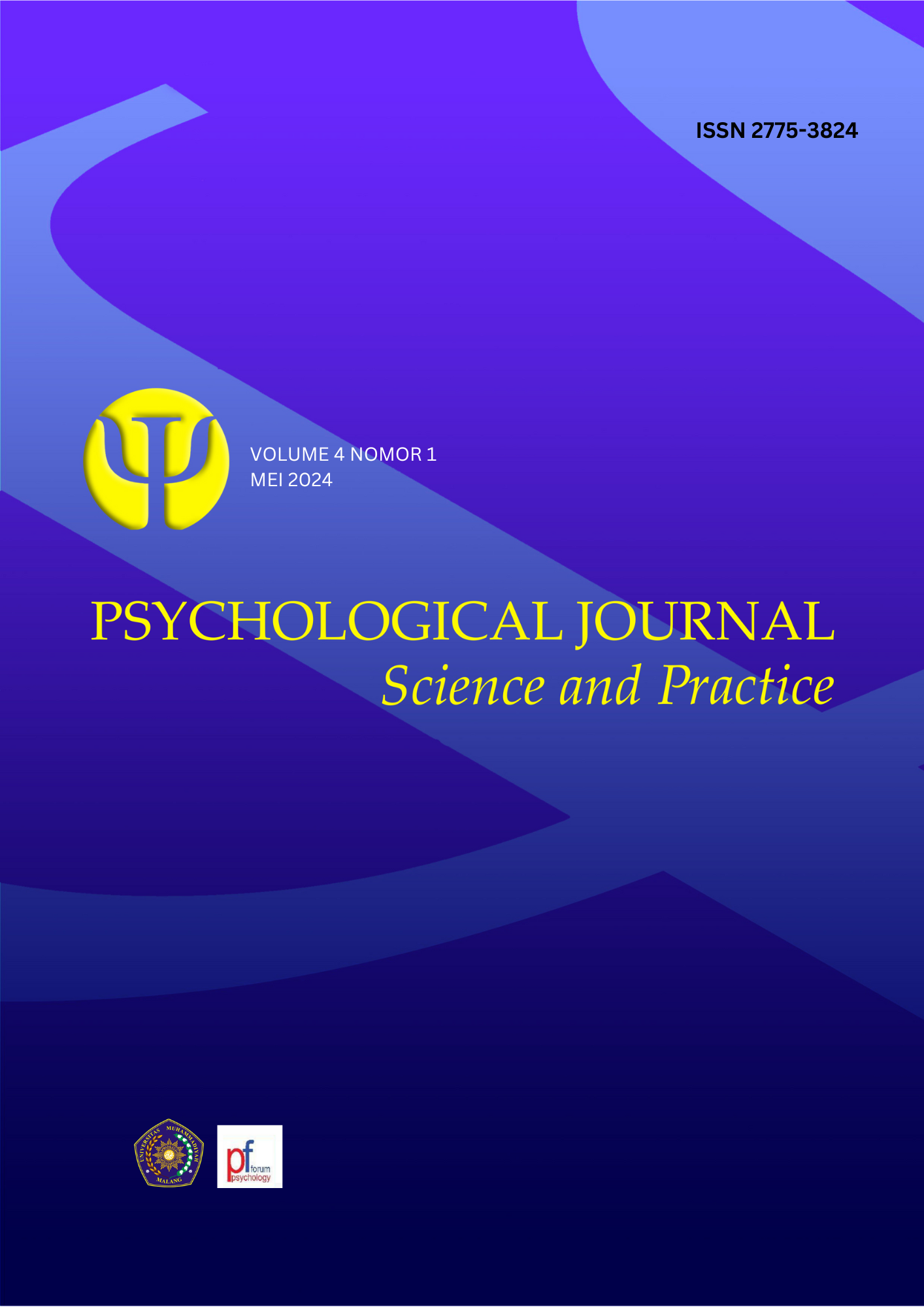Pengaruh positive thinking dalam meningkatkan self acceptance pada siswa
DOI:
https://doi.org/10.22219/pjsp.v4i1.33010Keywords:
Positive Thingking, Self Acceptance, StudentAbstract
This study is motivated by the researcher’s attention to class XII MA NWDI Sakra students who have low self-acceptance.
So this study aims to determine the effect of positive thinking in increasing the self-acceptance of class XII MA NWDI
Sakra students. This research was conducted at MA NWDI Sakra with a population of 63 students and the sample used
was as many as the population, namely 63 students because the population was less than 100. This study shows that
the Kolmogorov Smirnov calculation obtained p = 0.200¿ 0.05 which means that the data distribution has been normally
distributed so that data analysis with the t-test (Paired Sample t-test) can be done using the help of SPSS version 25.
The results of this study state that positive thinking affects increasing self-acceptance in class XII MA NWDI Sakra
students.
Downloads
References
Albrecht, K. (1980). Brain power: learn to improve your thinking skills. Prentice Hall, Inc.
Anu, & Kumar, S. (2022). Peer pressure and gender determine stress among adolescents. Scholarly Research Journal for Interdisciplinary Studies, 10(73), 17747–17755. https://doi.org/10.21922/srjis.v10i73.11680
Bilicha, P. N., Nashori, F., & Sulistyarini, I. (2022). Positive thinking training for improving self-acceptance of children in correctional facility. Jurnal Ilmiah Psikologi Terapan, 10(2), 89–93. https://doi.org/10.22219/jipt.v10i2.16557
Brack, C. J., Orr, D. P., & Ingersoll, G. (1988). Pubertal maturation and adolescent self-esteem. Journal of Adolescent Health Care, 9(4), 280–285. https://doi.org/10.1016/0197-0070(88)90250-1
Crockett, L. J., & Marcia, J. E. (1986). Identity and crisis: an empirical examination of the Erikson model. Journal of Personality and Social Psychology, 50(5), 881–893.
Erikson, E. H. (1969). Identity, youth and crisis. Behavioral Science, 14(2), 154–159. https://doi.org/10.1002/bs.3830140209
Faraza, T., Diyanti, N., & Novia, S. (2020). Effect of positive thingking training on self acceptance in students with disabilities . European Journal of Education Studies, 7.
Firmansyah, O. B. M., Bashori, K., & Hayati, E. N. (2019). Pengaruh terapi pemaafan dengan dzikir meningkatkan penerimaan diri pada orang dengan HIV/AIDS (ODHA). Psikis: Jurnal Psikologi Islami, 5(1), 13–23.
Guinagh, B. (1987). Cognitive self-help: positive thinking. In Catharsis and Cognition in Psychotherapy (pp. 81–89). Springer New York. https://doi.org/10.1007/978-1-4612-4776-0_9
Hurlock, E. B. (1974). Personality Development. McGraw-Hill. Inc.
Hurlock, E. B. (1986). Personality development. McGraw-Hill Inc.
Khoiryasdien, A. D., & Warastri, A. (2020). Pelatihan berpikir positif untuk meningkatkan penerimaan diri survivor bipolar di Yogyakarta. Jurnal Insigth Fakultas Psikologi Universitas Muhammadiyah Jember, 16(2), 317–335. https://doi.org/10.32528/ins.v%vi%i.2655
Limbert, C. (2004). Psychological wellbieng and satisfaction amongst military personel on unaccompanied tours: the impact of perceived social support and coping strategies. Journal of Military Psychology, 16(1), 37–51.
Lu, K., & Brown, C. (2023). Susceptibility to peer pressure among adolescents: biological, demographic, and peer-related determinants. Journal of Student Research, 11(1). https://doi.org/10.47611/jsr.v11i1.1576
Ma, Z. (2023). The study on the influence of academic pressure on academic performance. Journal of Education and Educational Research, 3(2), 106–109. https://doi.org/10.54097/jeer.v3i2.9045
Nofa, A., & Septiara, S. (2023). The relationship between self-concept and acceptance of young women’s physical changes during puberty at SMP 103 Jakarta in 2022. Asian Journal of Community Services, 2(1), 35–44. https://doi.org/10.55927/ajcs.v2i1.2474
Nurfitriana, D., Lestari Handayani, T., Dwi Susanti, H., & Alifatin, A. (2023). Relationship between physical changes and teen confidence during puberty. KnE Medicine, 447–453. https://doi.org/10.18502/kme.v3i2.13079
Paramita, R., & Margaretha. (2013). Pengaruh penerimaan diri terhadap penyesuaian diri terhadap penyesuaian diri penderita lupus. Jurnal Psikologi Undip, 12(1), 92–99.
Perloff, R. (1997). Daniel Goleman’s Emotional intelligence: Why it can matter more than IQ. . The Psychologist-Manager Journal, 1(1).
Putri, R. K. (2018). Meningkatkan self-acceptance (penerimaan diri) dengan Konseling Realita berbasis Budaya Jawa. Seminar Nasional Bimbingan Dan Konseling), 2(1), 2580–216. http://prosiding.unipma.ac.id/index.php/SNBK/index
Retno, I., Sudarsiwi, N. P., & Wahyuni, E. D. (2021). The relationship between positive thinking and self acceptance on elderly in the nursing homes: a literature review. Nurse and Health: Jurnal Keperawatan, 10(2), 228–239. https://doi.org/10.36720/nhjk.v10i2.257
Schueller, S. M., & Parks, A. C. (2014). The science of self-help. European Psychologist, 19(2), 145–155. https://doi.org/10.1027/1016-9040/a000181
Sekali, R. BR. K., & Tohir, A. (2020). Upaya meningkatkan penerimaan diri siswa. Jurnal Evaluasi Dan Pembelajaran, 2(2), 135–147.
Sylvia, A. Y. (2012). Pentingnya berfikir positif. Angkasa.
Tentama, F. (2014). Hubungan Positive Thinking dengan Self-Acceptance pada Difabel (Bawaan Lahir) di SLB Negeri 3 Yogyakarta Fatwa Tentama. Jurnal Psikologi Integratif, 2(2), 1–7.
Waney, N. C., Kristinawati, W., & Setiawan, A. (2020). Mindfulness dan penerimaan diri pada remaja di era digital. Insight: Jurnal Ilmiah Psikologi, 22(2), 73. https://doi.org/10.26486/psikologi.v22i2.969
Downloads
Published
How to Cite
Issue
Section
License
Copyright (c) 2024 Baiq Hardianti

This work is licensed under a Creative Commons Attribution-ShareAlike 4.0 International License.
Authors who publish with Psychological Journal: Science and Practice (PJSP) agree to the following terms:
- For all articles published in Psychological Journal: Science and Practice (PJSP), copyright is retained by the authors. Authors give permission to the publisher to announce the work with conditions. When the manuscript is accepted for publication, the authors agree to automatic transfer of the publishing right to the publisher.
- Authors retain copyright and grant the journal right of first publication with the work simultaneously licensed under a Creative Commons Attribution-ShareAlike 4.0 International License that allows others to share the work with an acknowledgment of the work's authorship and initial publication in this journal.
- Authors are able to enter into separate, additional contractual arrangements for the non-exclusive distribution of the journal's published version of the work (e.g., post it to an institutional repository or publish it in a book), with an acknowledgment of its initial publication in this journal.
- Authors are permitted and encouraged to post their work online (e.g., in institutional repositories or on their website) prior to and during the submission process, as it can lead to productive exchanges, as well as earlier and greater citation of published wor (See The Effect of Open Access).
This work is licensed under a Creative Commons Attribution-ShareAlike 4.0 International License.








